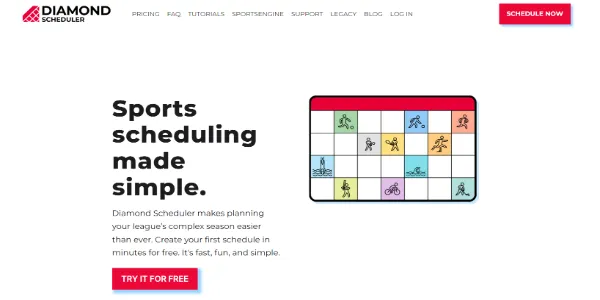
Schedule Constraints in Sports: What They Are and Types
Almost any sport that is played in an organized and competitive form uses scheduling so that games can be played efficiently.
When you look at the world of professional sports leagues, like the National Basketball Association, millions of dollars are spent each year just on team travel costs to and from games.
As an industry worth billions of dollars, there are many stakeholders—like TV networks—that pay massive amounts of money to make sure there are good schedules.
With schedule constraints, leagues can perform tasks like minimizing the distance traveled in a season or making sure high-profile rivalry games are played on weekends when ticket sales and viewership are the highest.
Not only do schedules and constraints play a big role in professional leagues, but they are also extremely important in amateur and youth sports.
For instance, leagues that use the same venue must make sure that they do not overlap their schedules.
Coaches might coach multiple teams in different sports or certain days might conflict with player and coach schedules.
Across-division schedules can be especially difficult to manage and constraints can optimize the schedule so that all teams are treated equally.
What is a schedule constraint?

In sports, schedule constraints are simply conditions that must be satisfied so that when the automated schedule is created and run, it meets the requirements for all of the teams in a league.
For professional leagues, these conditions can be centered around aspects like TV broadcasting contracts and league regulations.
More common constraints revolve around time, distance, maximum games per week, and others that we will cover in the following section.
What are the types of schedule constraints?
Different schedule constraints can be utilized depending on the sport and level at which the league is operating at.
They can also be dependent upon whether or not there are divisions or conferences, as well as the types of tournaments, such as single or double elimination or round-robin tournaments.
As more constraints are added to a sports schedule template and numerous bracket tournament, the harder it becomes to achieve one that is 100% successful and satisfies all requirements.
The following are the universal constraints used in sports.
1. Venue constraints
Venue constraints are applicable in several different ways.
One way venue constraints are used is to promote fairness of venue for each team.
Each team has either a home or away game, and this constraint works to provide the correct proportion for each team.
Certain venues also may not be able to meet the needed capacity of a game which often needs to be taken into consideration.
Another way this constraint is used is to prevent double booking.
This is particularly useful in the example of the NBA teams. The Los Angeles Lakers and the Los Angeles Clippers share the same arena.
Constraints must be used when both teams have a home game on the same day so that the games are not booked at conflicting times.
Similarly, when they play each other, one is designated as the home team and the other as the away team as equally as possible throughout the season.
Read More: Play-In Tournament Rules. Here's what the NBA Play-In Tournament is and how it's formatted!
2. Break constraints
A break, as it pertains to sports schedules, is consecutive home or away games.
Many leagues plan to execute schedules that minimize the duration and amount of breaks for any given team in a season.
While a minimum break constraint does not always work effectively with other constraints, they are widely useful to balance home and away games.
3. Distance and time constraints
Distance and time constraints are heavily focused on in both amateur and professional sports leagues because of the implications they have on costs if not properly managed.
The larger the number of teams, the more difficult these constraints can become to use to create an optimized schedule.
These constraints are popular research topics as distance corresponds directly with travel costs, and different algorithms are tested frequently to increase optimization.
An example of time constraints would be avoiding scheduling games for a team at 10 p.m. on a Monday and then at 11 a.m. the following day to establish a fair amount of time between games for players and coaches.
4. Carry-over constraints
Carry-over constraints are utilized for the sake of promoting balance in competition.
When there is no variety in competition level in regard to sequential games, a carry-over effect may occur, affecting the performance of a team.
This can best be explained in the following scenario:
Whenever Team A plays Team C, they have previously played Team B in the game before.
If Team B is either very weak or strong, it could have a carry-over effect on how Team A performs against Team C.
This is why variety throughout a season is important and why leagues look to spread out the times that teams play each other.
5. Fixed constraints
More commonly used in professional or collegiate sports, fixed constraints are often associated with the intention of scheduling rivalry games at certain times of the season or preventing two teams, such as conference champions, from playing at the beginning of a season.
Two examples of this are The University of New Mexico and New Mexico State college basketball games being reserved for weekends or certain high-profile NBA teams being fixed as Christmas Day matchups.
6. Special constraints
Special constraints are related to leagues scheduling specific games to increase television ratings, meet certain contractual obligations, maximize attendance, or other advantageous scenarios.
These sometimes go hand-in-hand with fixed constraints.
Special constraints are usually not taken into consideration for the entirety of the schedule, but rather implemented in certain portions of the season.
Read our related article where we show you how to create a 6 team league schedule to fit your needs.
How Diamond Scheduler uses constraint programming

Diamond Scheduler implements constraints in a way that allows coaches and league operators to create automated, customized, and successful schedules.
This is done by utilizing integer and goal programming to minimize travel distance among teams and maintain consistent home versus away games, creating a balanced schedule.
Diamond Scheduler also supplies other useful constraints including minimum days rest, coach conflicts, venue constraints, and more so that our users' leagues are able to be scheduled appropriately.
Final thoughts
Schedule constraints are a necessary cog in the sports-scheduling machine. There are different types of constraints that must be taken into account when creating a schedule for a league to avoid mistakes and keep teams happy.
Jeff Tipper is an avid sports fan who has a strong passion for basketball. A graduate of the University of New Mexico with a Bachelor's Degree in Operations Management, Jeff has experience in operations and claim processing and spends his free time writing articles and blogs focused on sports and various business topics.



